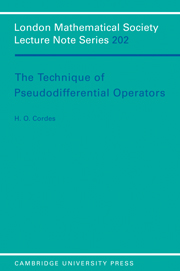Book contents
- Frontmatter
- Contents
- Preface
- Chapter 0 Introductory discussions
- Chapter 1 Calculus of pseudodifferential operators
- Chapter 2 Elliptic operators and parametrices in ℝn
- Chapter 3 L2-Sobolev theory and applications
- Chapter 4 Pseudodifferential operators on manifolds with conical ends
- Chapter 5 Elliptic and paraolic problems
- Chapter 6 Hyperbolic first order systems
- Chapter 7 Hyperbolic differential equations
- Chapter 8 Pseudodifferential operators as smooth operators of L(H)
- Chapter 9 Particle flow and invariant algebra of a semi-strictly hyperbolic system; coordinate invariance of Opψxm.
- Chapter 10 The invariant algebra of the Dirac equation
- References
- Index
Chapter 5 - Elliptic and paraolic problems
Published online by Cambridge University Press: 09 February 2010
- Frontmatter
- Contents
- Preface
- Chapter 0 Introductory discussions
- Chapter 1 Calculus of pseudodifferential operators
- Chapter 2 Elliptic operators and parametrices in ℝn
- Chapter 3 L2-Sobolev theory and applications
- Chapter 4 Pseudodifferential operators on manifolds with conical ends
- Chapter 5 Elliptic and paraolic problems
- Chapter 6 Hyperbolic first order systems
- Chapter 7 Hyperbolic differential equations
- Chapter 8 Pseudodifferential operators as smooth operators of L(H)
- Chapter 9 Particle flow and invariant algebra of a semi-strictly hyperbolic system; coordinate invariance of Opψxm.
- Chapter 10 The invariant algebra of the Dirac equation
- References
- Index
Summary
In this chapter we take up the lead of ch.O, sec.4, with regard to elliptic and parabolic problems. There we applied the Fourier- Laplace method to free-space problems of elliptic equations, and to evolutionary half-space problems of the (parabolic) heat equation, all with constant coefficients. We covered Dirichlet and Neumann problems in a half-space, for elliptic equations.
With the tools developed in I, II, III, IV we now can give a similar “Fourier–Laplace treatment” to much more general variable coefficients elliptic and parabolic problems. This may be done in “free space” (that is, in ℝn, or on a smooth compact manifold ω or on a noncompact ω with conical ends – but without the presence of boundary points). Such results are special cases of theorems on Green inverses of ψdo's already discussed, but they will be summarized (in more general form) in sec.l, below. If ω is compact we need ellipticity, else md-ellipticity of the operator. Not only (md-) elliptic operators on a complex-valued function but even maps between crosssections of vector bundles are considered.
Note that there is a different approach – a functional analysis approach – to these theorems, not using ψdo's at all. Elliptic theory, in its beginnings, was developed for 2-nd order equations. Such 2-nd order theory is of dominating importance for many physical applications. The Laplace, Helmholtz and Schroedinger operator each has its own well developed theory.
- Type
- Chapter
- Information
- The Technique of Pseudodifferential Operators , pp. 144 - 195Publisher: Cambridge University PressPrint publication year: 1995



